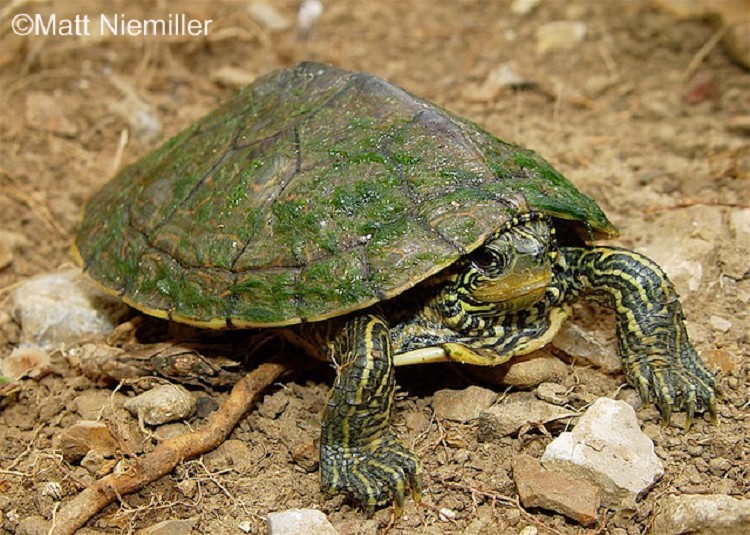Northern Map Turtle, Graptemys geographica
The Northern Map Turtle occurs in the Tennessee and Cumberland River drainages of middle and east Tennessee.
Description: A medium-sized, aquatic turtle (males 3.5 to 6.25; females 7.0 to 10.75 inches in length) having a low-keeled olive-green to brown carapace (upper shell) with intricate yellow lines, resembling roads or waterways on a map. Yellowish lines, over dark green skin, occur on the head, neck, and limbs with a distinct yellow dot behind eye. Plastron (lower shell) is light yellow, with brown borders along scutes (plates) in juveniles. Males have longer, thicker tails, while females are larger with broad heads.
Similar Species: False Map Turtle has a backward, yellow “L” mark behind eye with narrow, yellow neck stripes touching the edge of each eye. Mississippi Map Turtle has yellow crescent behind eye and neck stripes do not touch edge of eye. Painted Turtle has unkeeled shells. Eastern River Cooter has dark, donut-shaped markings under the marginal plates. Pond Slider has larger red (or sometimes yellow) ear patch and leg stripes. Ouachita Map Turtle has larger and more rectangular patch behind eye and higher keel.
Habitat: Prefers larger bodies of water with aquatic vegetation such as lakes, rivers, sloughs, and large ponds. Commonly seen basking on fallen trees or logs.
Diet: Omnivorous; mainly snails, crayfish, insects, dead fish, and some aquatic plants.
Breeding information: Adults breed in deep water during the spring and fall. Females excavate nest sites in open, well-drained areas such as sand bars or edges of fields and deposit 6-20 eggs. Incubation time lasts from 50-70 days resulting in hatching usually in the fall. Nest temperature determines the sexes of the young.
Status in Tennessee: Not listed in Tennessee, but Northern Map Turtles are impacted by human activities including pollution, development, automobiles, and getting caught on fishing hooks.
Fun Facts:
- A very wary species, which is quick to slip into the water from a basking log.
- Has been known to move about under ice in frozen lakes.
Best places to see in Tennessee: On fallen trees or logs in the Tennessee or Cumberland Rivers.
